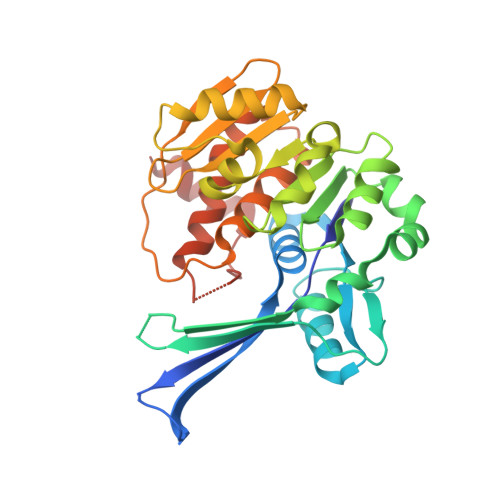Substrate-binding loop interactions with pseudouridine trigger conformational changes that promote catalytic efficiency of pseudouridine kinase PUKI.
Kim, S.H., Kim, M., Park, D., Byun, S., Rhee, S.(2022) J Biological Chem 298: 101869-101869
- PubMed: 35346685
- DOI: https://doi.org/10.1016/j.jbc.2022.101869
- Primary Citation of Related Structures:
7VTD, 7VTE, 7VTF, 7VTG, 7VVA - PubMed Abstract:
Pseudouridine, one major RNA modification, is catabolized into uracil and ribose-5'-phosphate by two sequential enzymatic reactions. In the first step, pseudouridine kinase (PUKI) phosphorylates pseudouridine to pseudouridine 5'-monophosphate. High-fidelity catalysis of pseudouridine by PUKI prevents possible disturbance of in vivo pyrimidine homeostasis. However, the molecular basis of how PUKI selectively phosphorylates pseudouridine over uridine with >100-fold greater efficiency despite minor differences in their K m values has not been elucidated. To investigate this selectivity, in this study we determined the structures of PUKI from Escherichia coli strain B (EcPUKI) in various ligation states. The structure of EcPUKI was determined to be similar to PUKI from Arabidopsis thaliana, including an α/β core domain and β-stranded small domain, with dimerization occurring via the β-stranded small domain. In a binary complex, we show that Ser30 in the substrate-binding loop of the small domain mediates interactions with the hallmark N1 atom of pseudouridine nucleobase, causing conformational changes in its quaternary structure. Kinetic and fluorescence spectroscopic analyses also showed that the Ser30-mediated interaction is a prerequisite for conformational changes and subsequent catalysis by EcPUKI. Furthermore, S30A mutation or EcPUKI complexed with other nucleosides homologous to pseudouridine but lacking the pseudouridine-specific N1 atom did not induce such conformational changes, demonstrating the catalytic significance of the proposed Ser30-mediated interaction. These analyses provide structural and functional evidence for a pseudouridine-dependent conformational change of EcPUKI and its functional linkage to catalysis.
- Department of Agricultural Biotechnology, Seoul National University, Seoul, Korea.
Organizational Affiliation:

















